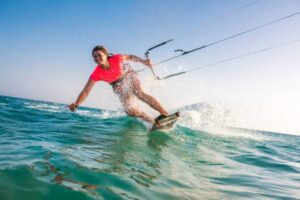Kite boarding is becoming a popular sport in many countries. It offers the potential for great thrills and a fitness benefit. However, kite boarding can be dangerous if you don’t know how to do it correctly. Here are some tips on how to learn it safely.
The heel side is the edge of a board on which a rider’s heels are (opposite to the toe side). It means riding with your heels down.
It is a water sport.
Kiteboarding is a water sport that uses a flying kite to power a board through the water. It is a safe, easy-to-learn sport that can be practised in almost any body of water. It has also become a popular competition sport for both men and women. The invention of the quick-release safety system has made kiteboarding much safer than it used to be. This improvement and the development of depower systems have greatly increased the sport’s popularity.
A kiteboard is a small composite or wood board steered by the wind and connected to the flying kite with lines. Several boards include directional surf-style boards, twin-tip boards that can operate in both directions and hydrofoil boards that generate lift through an underwater wing. Foil kiteboarding is a new trend that allows riders to ride in light winds.
Terms in kiteboarding include big air, back stall, and walk of shame. A backstart occurs when the kite stops moving in the air and drops. This can be caused by a lack of wind or by flying the kite at a high angle of attack. A walk of shame is a kitesurfer’s descent to the beach after losing control of their flying kite, often resulting in a crash. Other sports terms are wind window, zenith, and heel side.
It is a wind sport.
 Kiteboarding is a wind sport that uses a kite and a board to navigate over water. It can be performed in flat water or on waves. The sport also includes freestyle riding, emphasising kite-powered tricks like kite loops and leaps. In addition, there are course-racing events.
Kiteboarding is a wind sport that uses a kite and a board to navigate over water. It can be performed in flat water or on waves. The sport also includes freestyle riding, emphasising kite-powered tricks like kite loops and leaps. In addition, there are course-racing events.
Like other wind sports, kite boarding requires a solid understanding of wind power and how to control a kite. In addition, a safe rider should always be aware of the potential hazards of the sport and how to avoid them. These include being lofted, dragged, carried off wind, or blown downwind into objects (known as a “kitemark”). The risk can be reduced by maintaining a clear perception of the wind direction and speed, avoiding luffing, or flying a kite when blown towards land.
It is a fitness sport.
Kitesurfing is a full-body workout that requires balance and control. The core and leg muscles are utilised as you maneuver the kite at 12-15 knots wind speeds. The sport is also an excellent cardiovascular workout, burning calories and building muscle. It is a great alternative to other risky sports like scuba diving, which can be dangerous for beginners.
A few basic safety items are recommended for kiteboarding: a safety hook knife to cut tangled lines, a helmet in a high visibility colour, and a wet suit of reasonable thickness, depending on water temperature. A floatation vest is also recommended, as it will help keep you buoyant if you fall off your board. A good neck stretch is also helpful since you will spend much time staring at the kite in the air and may develop a stiff neck.
The flying lines are made of a high-performance material and have a small cross-sectional profile to minimise drag. They are usually between seven and thirty-three meters long. They run through a chicken loop on the control bar (also called the O-shit loop) and the spreader bar hook, which prevents the kite from being unhooked.
It is a sport of adventure.
Kiteboarding is a fun and challenging sport that can be as dangerous as rewarding. It requires a great deal of practice, but the equipment is safe and easy to handle and less costly than windsurfing. Moreover, it does not require a lot of strength, only skill and judicious use of the power. It is also very forgiving in terms of body size and shape. This sport has no age limits, and the entire family can enjoy it.
Some of the terminology used in kite boarding includes a walk of shame, wind-dummy, and zenith. Zenith refers to the point directly over the kiter’s head in the wind window. Walk of shame is when the rider walks back upwind from where they launched their kite. A wind dummy is a person who goes out and tests the wind before others start riding. This helps to avoid overpowering, a common mistake that new riders make.